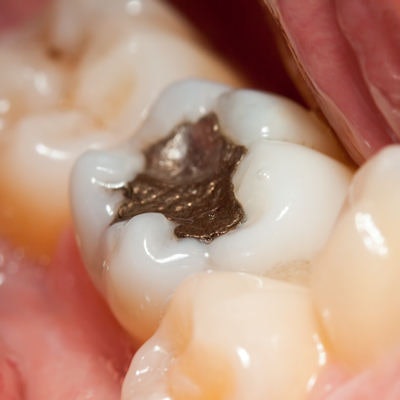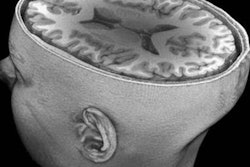
MR imaging at 7-tesla magnet strength may release toxic mercury from amalgam dental fillings, according to a new study published online June 26 in the journal Radiology. However, the effect was not found with the lower-strength 1.5-tesla magnets that are more commonly used in the clinical setting, the researchers noted.
The amount of mercury escaping amalgam -- also known as silver -- fillings by scanning with a 7-tesla MRI system exceeded safety levels set by the World Health Organization (WHO). Fortunately, the researchers from Turkey found no such adverse effect among samples of amalgam fillings in teeth scanned with a 1.5-tesla MRI protocol, which patients are far more likely to undergo in the clinical setting (Radiology, June 26, 2018).
"In our study, we found very high values of mercury after ultrahigh-field MRI," said lead author Selmi Yılmaz, PhD, in a statement. "This is possibly caused by phase change in amalgam material or by formation of microcircuits, which leads to electrochemical corrosion, induced by the magnetic field."
Yılmaz is from the oral and maxillofacial radiology department at the Akdeniz University Faculty of Dentistry in Antalya, Turkey.
Amalgam warnings
Some 100 million amalgam filling procedures are performed every year in the U.S., according to the American Dental Association. The use of dental amalgam, however, remains rather controversial, since the substance consists of approximately 50% of the known toxin mercury. The U.S. Food and Drug Administration considers amalgam fillings safe for adults and children older than age 6.
"In a completely hardened amalgam, approximately 48 hours after placing on teeth, mercury becomes attached to the chemical structure, and the surface of the filling is covered with an oxide film layer," Yılmaz explained. "Therefore, any mercury leakage is minimal."
Amalgam fillings currently are banned or restricted in Sweden, Norway, Denmark, and Germany. This year, the European Parliament banned amalgam in clinical practice for children younger than age 15 and for pregnant or lactating women.
Previous studies have shown that mercury can escape from amalgam fillings, with approximately 40% of it traveling into saliva and entering the gastrointestinal system, where some 10% of the mercury is absorbed. In the meantime, approximately 60% is released as mercury vapor and is either inhaled, enters the lungs, or is exhaled.
The question is what effect the extremely strong magnetic fields produced by MRI systems have on fillings -- particularly the superpowerful 7-tesla scanners that are increasingly being used on humans for research applications.
"To our knowledge, no previous study has tested the effects of 7-tesla MRI on mercury release from amalgam fillings," the authors wrote. "We hypothesized that 7-tesla MRI can trigger mercury release."
Extracted samples
The researchers scanned only extracted teeth for their study. In all, 60 teeth were randomly selected and divided into three groups of 20 each. The researchers opened two-sided cavities in each tooth and applied amalgam fillings. After nine days, two groups of teeth were placed in a solution of artificial saliva.
One group underwent a 7-tesla MRI scan (Magnetom Trio, Siemens Healthineers), while the second group underwent a 1.5-tesla MRI scan (Achieva, Philips Healthcare). Both protocols included a head coil, with teeth exposed to static and varying magnetic field for approximately 20 minutes. The 40 teeth were removed from the artificial saliva for analysis 24 hours after MR imaging.
The third group of teeth served as controls and did not undergo an MRI scan. Those samples also were placed in the artificial saliva solution and removed after 24 hours.
Mercury rising
When the researchers analyzed the artificial saliva, the mercury content in the 7-tesla samples was approximately four times the levels found in the 1.5-tesla group and the control group.
| Mercury content in saliva after MRI scanning | |||
| No MRI | 1.5-tesla MRI | 7-tesla MRI | |
| Mercury content in artificial saliva | 0.141 ± 0.15 ppm | 0.172 ± 0.06 ppm | 0.673 ± 0.18 ppm |
| p-value* | p < 0.001 | p < 0.001 | |
| p-value** | p = 0.84 | ||
*The p-value compares 7-tesla MRI with 1.5-tesla MRI and no MRI. Results are statistically significant.
**No statistically significant difference between 1.5-tesla MRI and no MRI results.
The researchers speculated that the very high values of mercury in the 7-tesla MRI samples may have been caused by a phase change in the amalgam material induced by the ultrahigh magnetic field.
So how do the mercury levels compare with recommended safety parameters? Based on the WHO's standard that the maximum daily dose of absorbed amalgam should be no greater than 0.122 ppm, this study measured dissolved mercury levels in the range of 0.325 to 1.0 ppm from 7-tesla MRI, which far exceeds WHO guidelines.
"An important point of discrimination concerning safety and hazard to human health is the amount of mercury that is absorbed by the vital tissues," the study authors wrote. “It is not clear how much of this released mercury is absorbed by the body,” Dr. Yılmaz said.
High-field MRI and amalgam mercury release
The researchers noted several limitations of their study. They did not know whether heat buildup occurs in amalgam fillings due to the MRI procedures that may affect the release of mercury. The artificial saliva samples were analyzed only once after 24 hours, so the release of mercury over time was not evaluated. They did not perform burnishing and polishing steps, which are normally performed in clinics to reduce corrosion. Finally, the ex vivo study did not include data on the patient-specific absorption rates of mercury.
Further studies may be needed to determine the relationship between high-field MRI and the release of mercury from dental amalgam, the authors concluded. In fact, three ongoing projects are targeting phase and temperature changes of dental amalgam across different magnetic fields, they noted.


.fFmgij6Hin.png?auto=compress%2Cformat&fit=crop&h=100&q=70&w=100)





.fFmgij6Hin.png?auto=compress%2Cformat&fit=crop&h=167&q=70&w=250)











